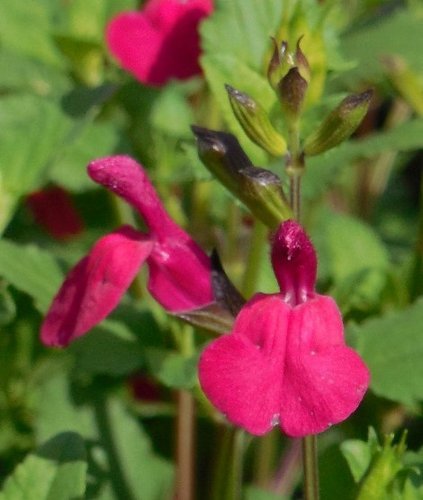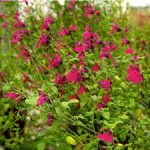Salvia ‘Killer Cranberry’ : is a small open bushy shrub 80cm -1mH with the palest pink semi tubular flowers in late winter/ spring for a sunny position.

Salvia ‘Killer Cranberry’ is a bright robust Salvia that flowers for most of the year.
Flowers: are a typical microphylla type flower with soft crimson hairs on the hood and reflexed bottom lobes. All lobes are the same colour. The middle lobe is wide, slightly split, wide enough to touch the other smaller side lobes.
There is a faint pale patch around the throat to indicate a beeline. The throat area is wide open for bees and other insects to enter.
Most flowers are in opposite pairs around a coloured flowering stem, these are held above the foliage to catch passing insects.
Flowering begins in spring, continues throughout the summer and well into autumn.
Calyces: are predominantly green, with some colouring on the exposed side. Calyces are shiny with few hairs, ribbed and pointed. Most calyces will drop if not pollinated, just leaving a flowering stem to be cut off.
Leaves: are a typical microphylla type leaf, being oval, mid green, veins clearly seen and rounded crenations around the margins. Leaves are thin textured with slight undulations.Most stems are well clothed.
Salvia ‘Killer Cranberry’ is a great plant to brighten up a garden bed, in a full sun position. Great in an informal border with grasses and the different heights of other small shrubs and perennials. This Salvia certainly is eye catching grown en masse or as a long border.
A good addition to any garden for that splash of colour. Very attractive to bees, butterflies and other pollinating insects.
Tough and hardy for the dry hot summer season as well as the cold of the winter months, tolerating a light frost quite well.
At the end of autumn, after the main flowering has finished and the plant be looking a bit tired, then it’s time to cut back and tidy up.
Cut stems back to good green buds, cut out any dead or twiggy stems. Clean out dead leaves. Feed to encourage the new season’s growth , mulch well to keep the root area warm in winter. Feed again in spring for those new buds appearing, top up mulch to keep the root area cool during the summer months.
Propagation: usually by tip cuttings taken at any time of year.
Back to Varieties



